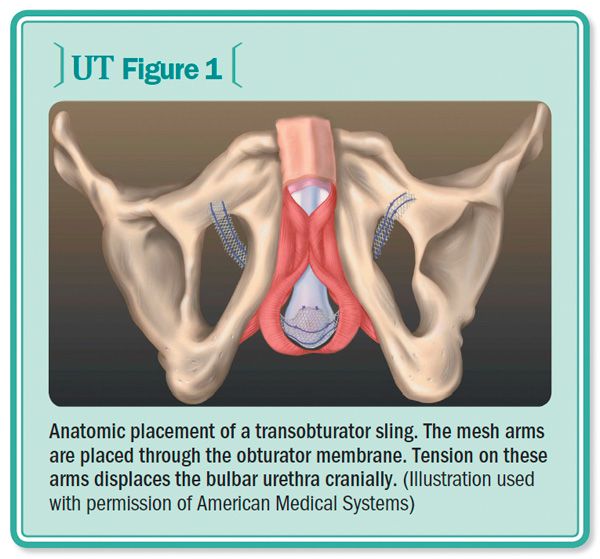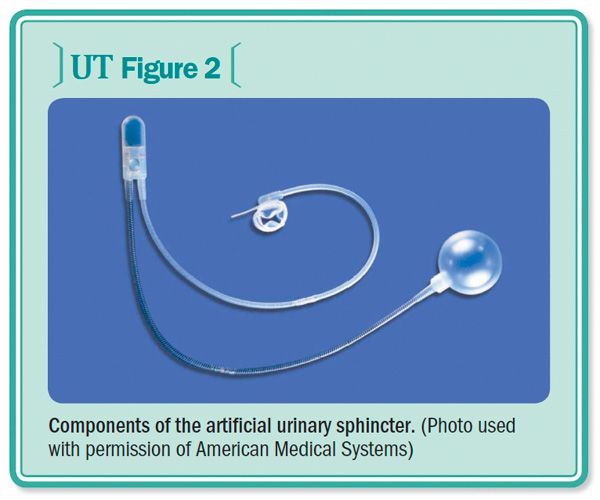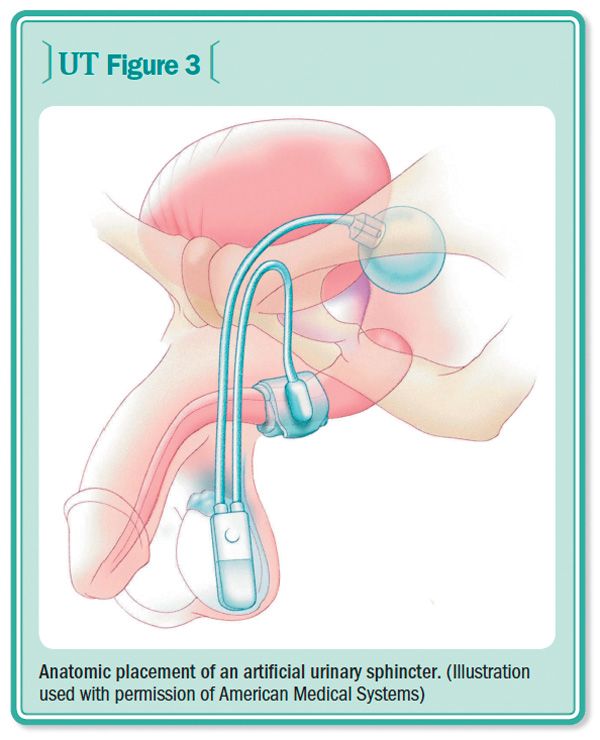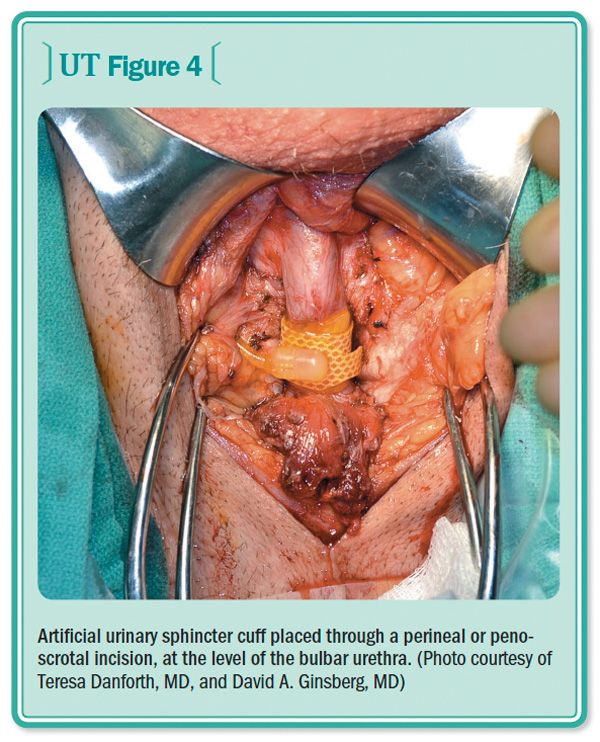Article
How to manage post-prostatectomy incontinence
In this article, we briefly review the evaluation of patients with PPI and discuss the benefits and drawbacks of conservative, pharmacologic, injection, and surgical treatments.



Post-prostatectomy incontinence (PPI) prevalence has been reported to range between 1% and 87% based on timing of evaluation and variable definitions of incontinence, including zero pads, one security pad, and zero or one pad per day (Korean J Urol 2012; 53:511-8; BJU Int 2011; 107[suppl 3]:7-10), with 8% to 12% of patients seeking treatment (Curr Opin Urol 2010; 20:302-8). When counseling patients, urologists often quote low rates of PPI, reflecting the rates of severe or total incontinence. PPI is one of the most important factors influencing quality of life after radical prostatectomy, with studies showing that even the use of a security pad may have a significant impact on quality of life.
In this article, we briefly review the evaluation of patients with PPI and discuss the benefits and drawbacks of conservative, pharmacologic, injection, and surgical treatments.
Evaluation
One of the most important aspects of persistent PPI management is evaluation. While many urologists believe that recovery of continence occurs during the first year after radical prostatectomy, continued improvement may occur over 2 years after surgery. A study by Lepor et al noted the percentage of men using <1 pad/day improving from 71% to 87%, 92%, and 98.5% at 3, 6, 12, and 24 months, respectively (Wessells H, Peterson A. Surgical procedures for sphincteric incontinence in the male: The artificial urinary sphincter and perineal sling procedures. In: Wein AJ, Kavoussi LR, Novick AC, et al, eds. “Campbell-Walsh Urology,” 10th ed. Philadelphia: WB Saunders, 2012. pp 2290-305). Evaluation of PPI is usually delayed until 12 months have passed since surgery; however, there is no data identifying the optimal assessment time.
Initial evaluation with a history, physical examination, urinalysis, and postvoid residual is appropriate. Voiding diaries, pad tests, and incontinence questionnaires may also be useful. Once initial assessment is completed, conservative options may be initiated.
When considering surgical intervention, cystoscopy allows for evaluation of the health of the urethral tissue and the ruling out of a urethral stricture and bladder neck contracture. Urodynamics can be considered to evaluate for detrusor function, bladder compliance, and detrusor overactivity.
Continue to the next page for more.
Conservative treatments
Following radical prostatectomy, patients are often asked to perform pelvic floor muscle therapy (ie, Kegel exercises). It is important to keep in mind that patients who are not neurologically intact may not be able to perform adequate pelvic floor contractions. Patients may have difficulty locating their pelvic floor; use of a physical therapist, with or without the aid of biofeedback, may help the patient contract the pelvic musculature to strengthen the urethral sphincter. Studies have shown a quicker return to continence with pelvic floor muscle training, especially in those who have the aid of a structured program; however, these differences are minimal at 1-year follow-up (Eur Urol 2005; 48:734-8).
Pelvic floor electrical stimulation and external magnetic stimulation are thought to help in strengthening of the pelvic floor. Exercises may be continued indefinitely until the patient is able to maintain continence. For patients who are not motivated or those with more severe incontinence, pelvic floor exercises will likely not be adequate.
Penile compression devices such as a Cunningham clamp (Bard Medical, Covington, GA) may allow patients to maintain continence. Other behavioral therapies, such as avoiding bladder irritants and limiting fluid intake, may also help, but not enough data are available.
Pharmacologic therapy
Currently, there is no FDA-approved medical therapy for stress urinary incontinence (SUI). A few studies have looked at the use of duloxetine, a combined serotonin and norepinephrine uptake inhibitor, for PPI (Eur Urol 2007; 51:1559-64; Eur Urol 2011; 59:148-54). In Europe, duloxetine is currently approved for stress urinary incontinence in females. The mechanism of action is not completely understood, but it is thought that duloxetine works centrally and aids in the contraction of smooth muscle, thus strengthening the urethral sphincter.
Timing of surgical intervention
Most urologists agree that any surgical intervention should be held off for at least 12 months post-prostatectomy. Most studies show surgical treatment is delayed until at least 41 months (Korean J Urol 2012; 53:511-8). Patients with severe or continuous incontinence may benefit from earlier intervention, as conservative measures will not likely be valuable.
Injection therapy
Multiple types of injection therapy have been used in the past, including collagen, polydimethylsiloxane (Macroplastique [Uroplasty, Minneapolis]), dextranomer hydaluronic acid (Deflux [Salix Pharmaceuticals, Raleigh, NC]), and pyrolytic carbon microspheres (Durasphere [Coloplast, Minneapolis]). Collagen is no longer used as it is no longer manufactured. The ease of use with minimal morbidity presents injections as an attractive option for PPI.
The disadvantage of injection therapy is that it may require multiple injections at the level of the bladder neck and/or external sphincter to achieve continence, and cure rates are estimated at 20% to 26% long term (Korean J Urol 2012; 53:511-8; BJU Int 2011; 107[suppl 3]:7-10). Due to the limited efficacy compared to outcomes described below with male slings and the artificial urinary sphincter, injectable therapy is rarely used in men with PPI.
Continue to the next page for more.
Male slings
Male slings were introduced in 2000 for the treatment of mild to moderate stress urinary incontinence. Slings do have several advantages over the artificial urinary sphincter, including lack of mechanical parts, no need for device training or manual dexterity to use the device, reduction in cost, and the ability to use the device immediately. Various techniques have been developed, including the bone-anchored sling, which is no longer available, transobturator sling, and adjustable retropubic sling.
Slings should be used with caution in patients with prior radiation (secondary to poor outcomes), poor detrusor contractions, those with severe incontinence, and obese patients. Placement of slings in obese patients is more technically challenging, and obesity (defined as BMI >30 kg/m2) has also been shown to yield lower cures rates in retrospective studies of transobturator slings, with similar complication rates compared to studies of overweight and ideal-weight patients (Can J Urol 2012; 19:6088-93).
Bone-anchored slings compress the bulbar urethra with a piece of silicone-coated polypropylene mesh, resulting in an increase in fixed urethral resistance. Success rates of 40% to 88%, based on daily pad use, have been reported (BJU Int 2011; 109:328-44).
Transobturator slings are placed using an “outside-in” technique through the obturator foramen and sutured to the bulbar urethra. The resultant cranial displacement of the urethra augments its sphincteric function by repositioning and lengthening the urethra (figure 1). Success rates are quite variable, from 9% to 79%, depending on definition of cure (BJU Int 2011; 109:328-44).

Continue to the next page for more.
The adjustable retropubic sling consists of a silicone foam pad placed underneath the bulbar urethra attached to silicone struts that are passed with a trocar through the retropubic space and fixed over the rectus fascia with silicone washers. These washers are filled with radiopaque contrast, which allows for future adjustment of tensioning through a suprapubic incision. Success rates have been reported at 72% to 79% with patients needing zero to three subsequent tensioning procedures.
Adverse events for male slings include urinary retention, wound infection with possible explantation, postoperative pain or paresthesias, de novo urinary urgency, sling failure, rare urethral erosion, and system dislocation (adjustable slings).
Continence balloons
The most recent innovation for the treatment of PPI is the implantation of adjustable continence balloons (ProACT, Uromedica, Plymouth, MN). Two balloons are placed on either side of the urethra, providing passive urethral compression. This procedure is not recommended for patients with prior radiation secondary to higher risk of complications and failure and is not currently available in the United States.
Implantation of the balloons is performed through a perineal incision. Tubing runs from the balloon to a titanium port on the posterior scrotum. The balloons are filled and can be adjusted monthly to optimize outcomes through the port.
Success rates, defined as zero or one pad per day, have been reported at approximately 70%. However, this may require multiple refills of the balloons (Curr Opin Urol 2010; 20:302-8). Adverse events include urinary retention, balloon failure, infection, erosion, and migration, with removal necessary in up to 17% of patients.
Continue to the next page for more.
The artificial urinary sphincter
The gold standard for treatment of moderate to severe PPI is the artificial urinary sphincter, or AUS (American Medical Systems, Minnetonka, MN). Initially developed in 1973, it has undergone multiple modifications to allow for longer life and improved continence rates. The AUS has long-term data, with patient satisfaction rates of 72% to 90% at 23.4 months to 7.7 years follow-up (Adv Urol 2012; 2012:835290). Social continence (0-1 pads per day) has been shown to be 97% at 23.4 months, with long-term rates of 54% to 77% at follow-up of 6.8 to 7.7 years.

The AUS has three components: cuff, pump, and reservoir (figure 2). One of the more recent modifications has been the introduction of a smaller, 3.5-cm cuff size (more commonly used in revisions). Tandem cuffs may also be placed for better continence if one cuff does not achieve adequate results. If there is significant risk of erosion, transcorporal cuff placement may be considered. The reservoir is available in multiple pressures: the 61-70 cm of water cuff as standard and the 51-60 cm of water cuff used for patients who have undergone radiation. The control pump is placed in the anterior scrotum to allow easy patient access (figures 3 and 4). Postoperatively, the AUS remains deactivated for an average of 6 weeks (longer if the patient has undergone radiation).


Adverse events include infection, erosion, urethral atrophy, and mechanical failures. Studies are variable, but some suggest that complications might be higher in patients who have undergone radiation. Infection and urethral erosion require explantation of the implant (with subsequent replacement as desired), whereas urethral atrophy and mechanical failures may require revision. It is very important to evaluate the patient’s manual dexterity and mental status to assess their ability to use the control pump before proceeding with AUS placement.
Continue to the next page for more.
Treatment of urgency incontinence
Patients with PPI may have urgency with or without urgency incontinence (solely or concomitantly with SUI). Urodynamics with or without fluoroscopy may be helpful in the diagnosis of detrusor overactivity if the patient’s symptoms are unclear. First-line treatments are behavioral modification with or without an anticholinergic (J Urol 2012; 188[suppl 6]:2464-72). Pelvic floor muscle exercises to suppress urgency may be difficult to differentiate for patients who are also trying to strengthen the pelvic floor for SUI.
The most common adverse effects of anticholinergics are dry mouth and constipation, and care should be taken in elderly patients due to possible altered mental status.
In 2012, mirabegron (Myrbetriq), a selective β3 agonist, was introduced for the treatment of overactive bladder at 25 and 50 mg daily dosing. Unlike anticholinergics, mirabegron has low rates of dry mouth, constipation, and urinary retention, making it more tolerable. Mirabegron has not yet been studied in men with PPI and urinary urgency, but similar efficacy is to be expected. Other options for urge incontinence refractory to oral medications include neuromodulation or intravesical onabotulinumtoxinA (Botox) injections.
How to select a treatment
Choice of treatment is dependent on multiple factors, including patient comorbidities, history of radiation therapy, bladder function, and patient and surgeon preference. In patients with mixed incontinence, choice of treatment depends on the most bothersome symptoms. If the patient is most bothered by urinary urgency or the primary cause of incontinence is found to be detrusor overactivity on urodynamics, one could consider treating urgency symptoms with anticholinergics prior to surgical intervention for SUI. Patients must understand that if their goal is to be dry, treatment of SUI will need to be addressed even after urgency is adequately treated.
Regarding treatment of SUI, patients who wish to avoid any invasive procedure or are not candidates for these procedures are best suited to undergo conservative measures such as pelvic floor therapy, with the understanding that these therapies have lower cure rates. Male slings are primarily indicated for patients with mild to moderate stress urinary incontinence and those patients who do not want to or cannot use a mechanical device. The AUS can be used in all patients, with a trend toward those patients with moderate to severe SUI who are able to manipulate the pump without difficulty.
Conclusions
PPI has a significant impact on quality of life and has multiple options for treatment. Conservative measures, including pelvic floor exercises, may be started early. Options for less severe incontinence include injectable therapy and male slings. The AUS remains the gold standard for severe PPI and has good results in both the non-radiated and radiated patient.UT
Subscribe to Urology Times to get monthly news from the leading news source for urologists.
















